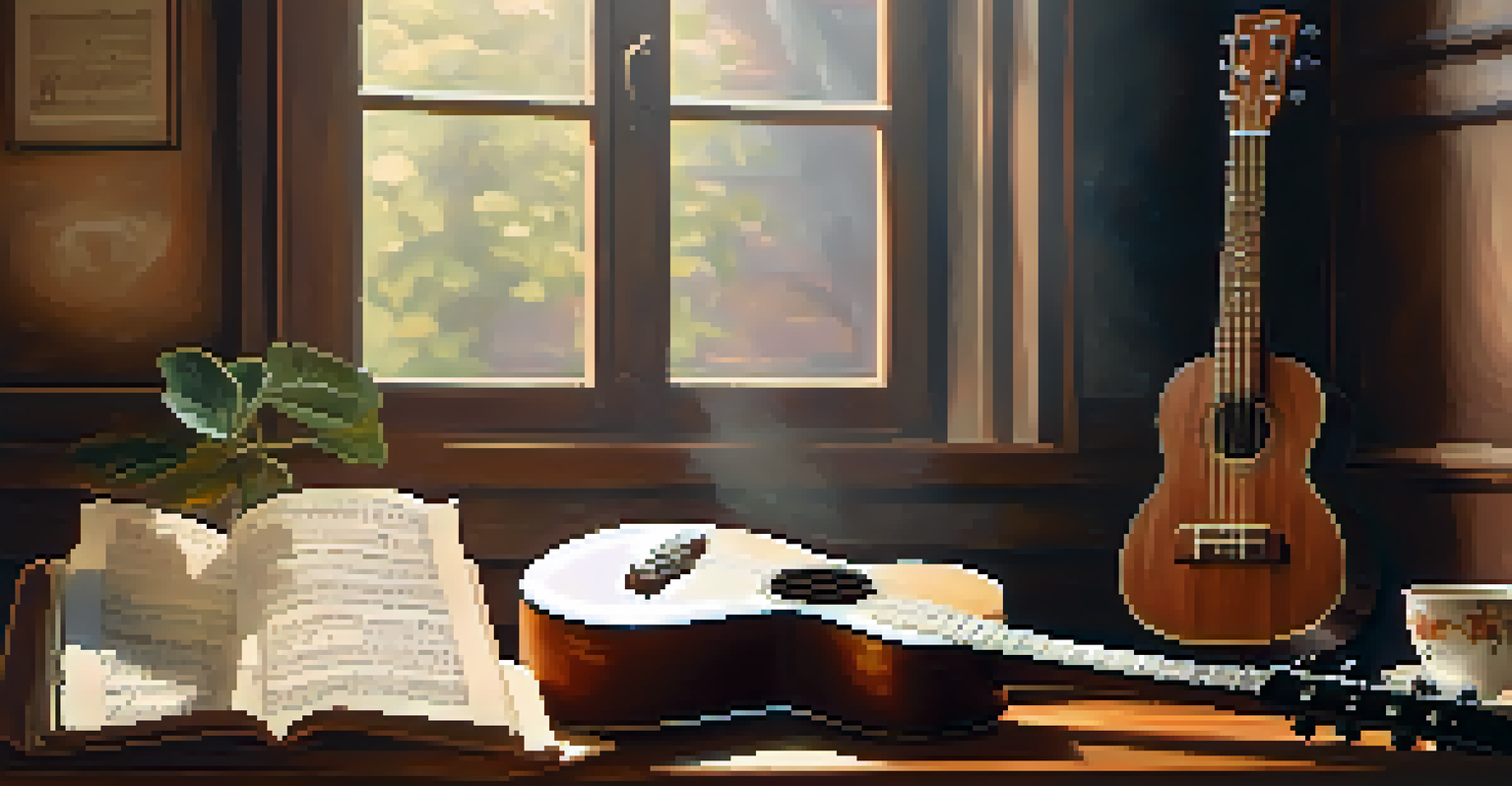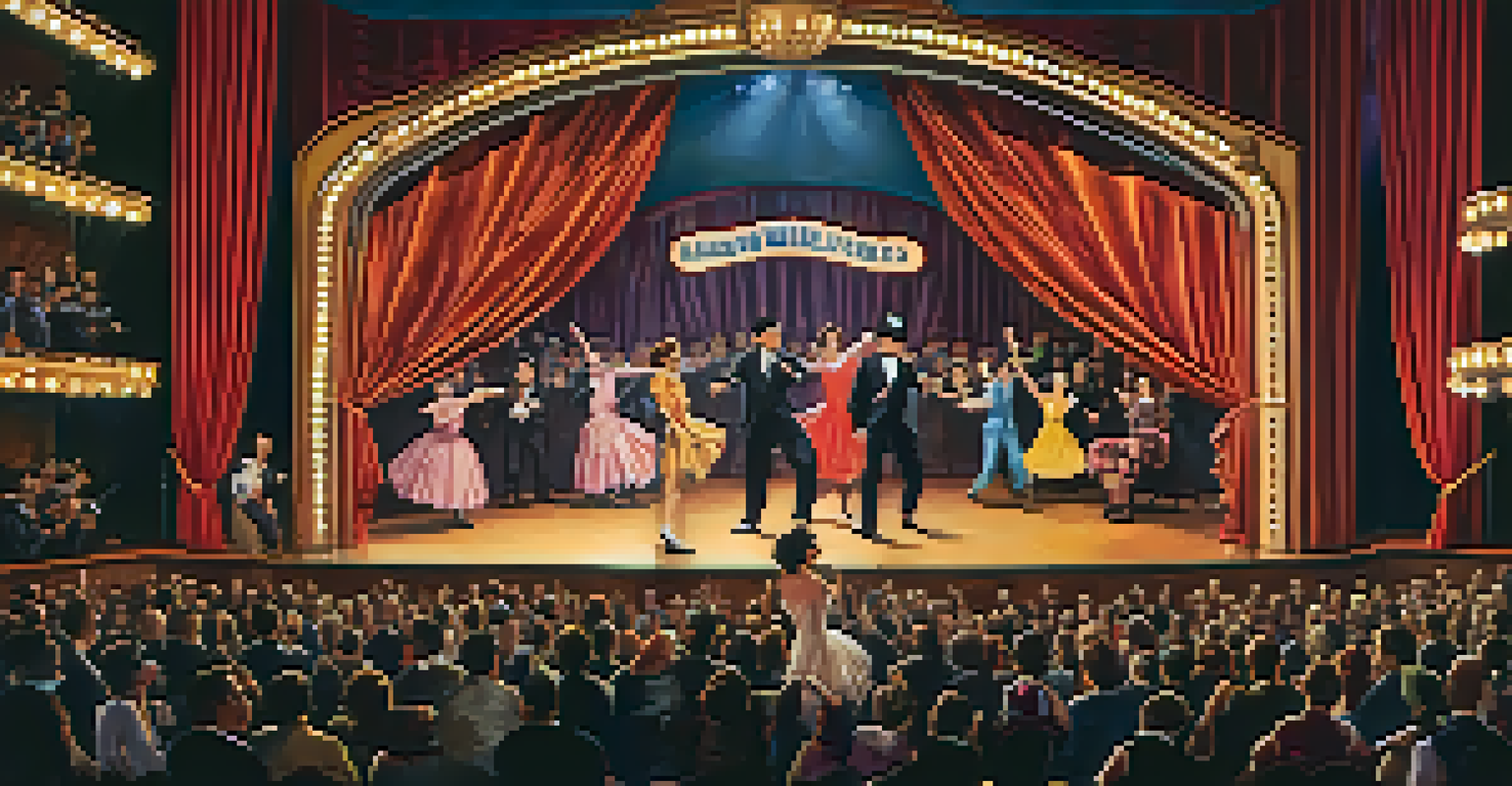The Ukulele in Early 20th Century American Music

The Ukulele's Arrival in America: A Hawaiian Gift
The ukulele made its way to America in the late 19th century, primarily due to Hawaiian immigrants. Its unique sound and playful character caught the attention of many musicians and audiences alike. By the early 20th century, it began to garner popularity, especially in the mainland U.S., as people sought new forms of entertainment.
The ukulele is the instrument of the people. It brings joy, music, and a sense of community wherever it goes.
As the ukulele became more accessible, it started to appear in various musical genres, from folk to jazz. This diverse appeal helped it find a special place in American hearts, reminiscent of the carefree spirit of the islands. In many ways, its arrival marked the beginning of a love affair between the instrument and the American music scene.
The instrument's light, portable design made it a favorite for casual gatherings and performances, allowing anyone to join in the fun. As people gathered around to strum and sing, the ukulele became synonymous with joy and togetherness, setting the stage for its future influence.
The Ukulele in Vaudeville and Popular Entertainment
During the early 20th century, vaudeville became a dominant form of entertainment across America. Performers often incorporated the ukulele into their acts, using its cheerful sounds to captivate audiences. This inclusion helped solidify the ukulele's status as a staple in American entertainment.

Vaudeville acts showcased a variety of talents, and the ukulele's versatility made it a perfect fit. Whether accompanying a comedian's routine or highlighting a singer's vocals, the ukulele added a layer of charm and playfulness. The instrument became a symbol of light-heartedness during an era filled with social change.
Ukulele's Journey to America
The ukulele arrived in America in the late 19th century, quickly becoming a beloved instrument due to its unique sound and playful character.
As audiences flocked to theaters, the ukulele's presence in vaudeville paved the way for its appearance in other entertainment forms, including film and radio. This exposure significantly contributed to its rising popularity, making it a household name by the mid-20th century.
The Rise of Tin Pan Alley and the Ukulele
Tin Pan Alley, the heart of American popular music publishing, played a crucial role in popularizing the ukulele. Songwriters began to write catchy tunes specifically for the ukulele, knowing its playful sound would resonate with the public. This led to an explosion of ukulele songs that audiences couldn't resist.
Music is the shorthand of emotion, and the ukulele is the perfect way to express that joy and freedom.
With hits like 'My Little Grass Shack in Kealakekua, Hawaii' and 'Ain't She Sweet,' the ukulele became synonymous with the joyous melodies of the era. These songs highlighted the instrument's cheerful tone, making it an essential part of the American soundscape. The catchy hooks made them perfect for sing-alongs, further enhancing the ukulele's appeal.
As Tin Pan Alley continued to churn out songs, the ukulele found its way into the hands of aspiring musicians everywhere. This grassroots movement transformed the instrument into a symbol of creativity and expression, encouraging many to pick up the ukulele and join the musical revolution.
Influence on Jazz and the Ukulele's Evolution
The early 20th century also saw the emergence of jazz, a genre that embraced improvisation and creativity. The ukulele found its niche within this vibrant scene, with musicians experimenting and incorporating it into their jazz ensembles. This melding of styles showcased the instrument's adaptability and further solidified its place in American music.
Prominent jazz musicians began to feature the ukulele in their performances, pushing the boundaries of what the instrument could do. The ukulele's distinct sound added a unique flavor to jazz, enriching the genre and inspiring countless artists. Its presence in jazz helped to elevate the instrument's status from novelty to serious musical tool.
Cultural Icon in Entertainment
Throughout the early 20th century, the ukulele became a staple in vaudeville and popular music, captivating audiences with its charm and versatility.
As a result, the ukulele began to evolve, with players developing new techniques and styles that expanded its musical possibilities. This ongoing evolution allowed the ukulele to remain relevant, adapting to the changing landscape of American music while still retaining its charm.
Cultural Impact of the Ukulele in American Society
The ukulele's influence extended beyond just music; it became a cultural icon in American society. Its cheerful sound and approachable nature made it a symbol of the carefree lifestyle many sought during the early 20th century. The instrument represented a sense of freedom and joy amid the challenges of the time.
As the ukulele gained popularity, it also became associated with leisure activities and social gatherings. Families would gather around to play, sing, and share stories, reinforcing the sense of community that the ukulele fostered. This communal aspect contributed to its growing popularity, making it a beloved part of American culture.
Through its widespread appeal, the ukulele transcended social and economic barriers, inviting everyone to join in the music-making experience. This inclusiveness helped solidify the ukulele's place in the American musical landscape, ensuring its legacy would continue for generations to come.
The Ukulele's Resurgence in the Mid-20th Century
By the mid-20th century, the ukulele experienced a resurgence in popularity, thanks in part to the folk music revival. Artists like Arthur Godfrey and the Kingston Trio showcased the instrument in their performances, reigniting interest among listeners. This revival brought the ukulele back into the spotlight, introducing it to a new generation of music lovers.
The folk movement's emphasis on simplicity and authenticity resonated with audiences, making the ukulele a perfect fit. It was easy to learn and play, encouraging many to pick it up and explore their musical talents. This accessibility helped the ukulele become a symbol of the folk era, bridging the gap between traditional music and contemporary sounds.
Resurgence in Folk Music
The mid-20th century saw a revival of the ukulele, as artists embraced its accessibility and simplicity, making it a symbol of the folk music movement.
As a result, the ukulele became a staple in folk music circles, with countless songs written for the instrument. This resurgence not only revitalized the ukulele's presence in American music but also laid the groundwork for its future popularity in various genres.
Legacy of the Ukulele in American Music History
The legacy of the ukulele in early 20th century American music is undeniable. It played a pivotal role in shaping the sound of popular music, influencing countless artists and genres. Its cheerful tone and versatile nature continue to inspire musicians to this day.
Today, the ukulele's influence can be seen in various musical styles, from pop to rock to indie. Many contemporary artists incorporate the ukulele into their work, showcasing its timeless appeal. This enduring presence is a testament to the instrument's ability to connect with audiences across generations.

As we look back at the ukulele's journey through American music history, it serves as a reminder of the power of creativity and expression. The ukulele not only brought joy to countless individuals but also shaped the landscape of American music, leaving a lasting impact that will continue to resonate for years to come.